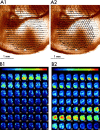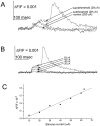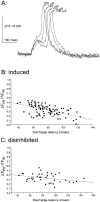Sustained and accelerating activity at two discrete sites generate epileptiform discharges in slices of piriform cortex
- PMID: 9952407
- PMCID: PMC6786016
- DOI: 10.1523/JNEUROSCI.19-04-01294.1999
Sustained and accelerating activity at two discrete sites generate epileptiform discharges in slices of piriform cortex
Abstract
When near-threshold electrical stimulation is used to evoke epileptiform discharges in brain slices, a latent period of up to 150 msec elapses before the discharge begins. During this period most neurons are silent, and abnormal electrical activity is difficult to detect with microelectrodes. A fundamental question about epileptiform activity concerns how synchronous discharges arise abruptly in a relatively quiescent slice. This issue was addressed here by using voltage imaging techniques to study epileptiform discharges in rat piriform cortex slices. These experiments revealed two distinct forms of electrical activity during the latent period. (1) A steeply increasing depolarization, referred to here as onset activity, has been described previously and occurs at the site of discharge onset. (2) A sustained depolarization that precedes onset activity, referred to here as plateau activity, has not been described previously. Plateau and onset activity occurred in different subregions of the endopiriform nucleus (a region of high seizure susceptibility). When cobalt or kynurenic acid was applied focally to inhibit electrical activity at the site of plateau activity, discharges were blocked. However, application of these agents to other nearby sites (except the site of onset) failed to block discharges. Plateau activity represents a novel form of electrical activity that precedes and is necessary for epileptiform discharges. Discharges thus are generated in a sequential process by two spatially distinct neuronal circuits. The first circuit amplifies and sustains activity initiated by the stimulus, and the second generates the actual discharge in response to an excitatory drive from the first.
Figures












References
-
- Ayala GF, Dichter M, Gumnit RJ, Matsumoto H, Spencer WA. Genesis of epileptic interictal spikes. New knowledge of cortical feedback systems suggests a neurophysiological explanation of brief paroxysms. Brain Res. 1973;52:1–17. - PubMed
-
- Behan M, Haberly LB (1999) Intrinsic and efferent connections of the endopiriform nucleus in rat. J Comp Neurol, in press. - PubMed
-
- Behan M, Sachdev P, Haberly LB. Intrinsic and efferent connections of the endopiriform nucleus that may contribute to epileptogenesis. Soc Neurosci Abstr. 1997;23:317.8.
-
- Burwell RD, Witter MP, Amaral DG. The perirhinal and postrhinal cortices of the rat: a review of the neuroanatomical literature and comparison with findings from the monkey brain. Hippocampus. 1995;5:390–408. - PubMed
Publication types
MeSH terms
Substances
Grants and funding
LinkOut - more resources
Full Text Sources
Medical
